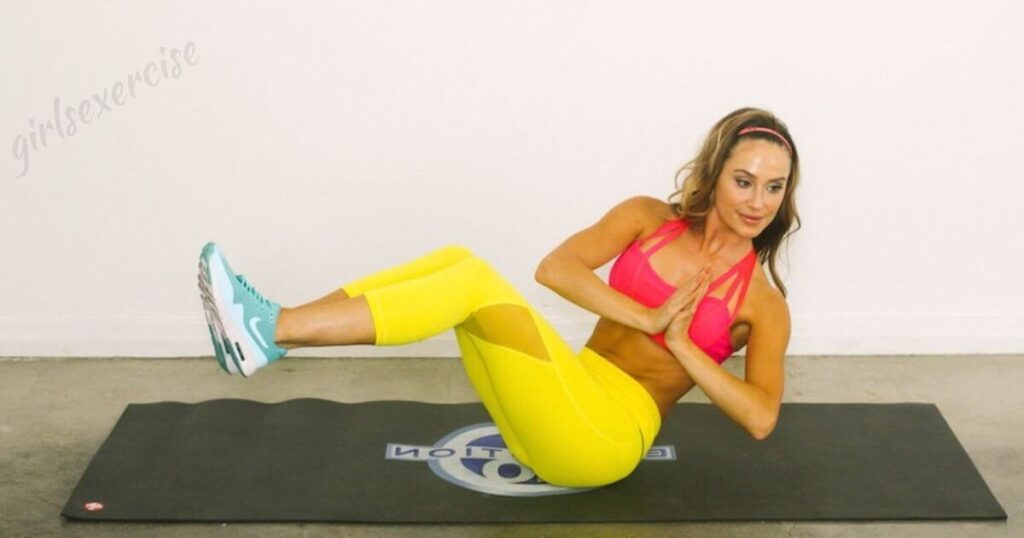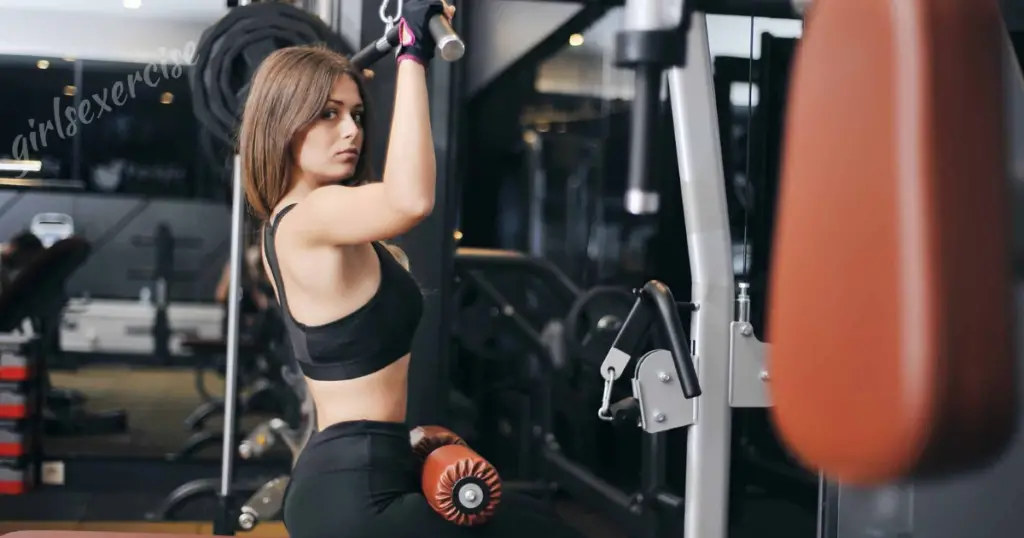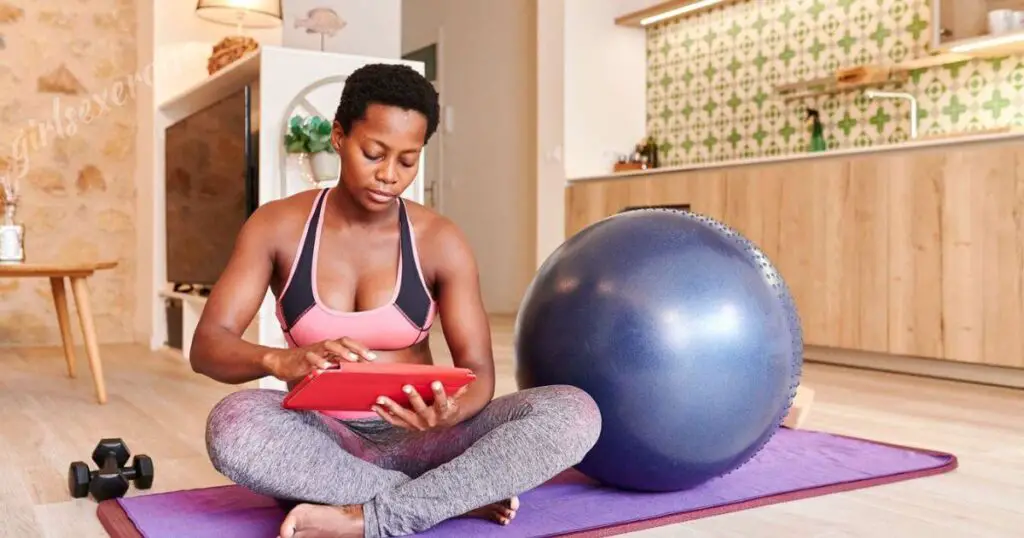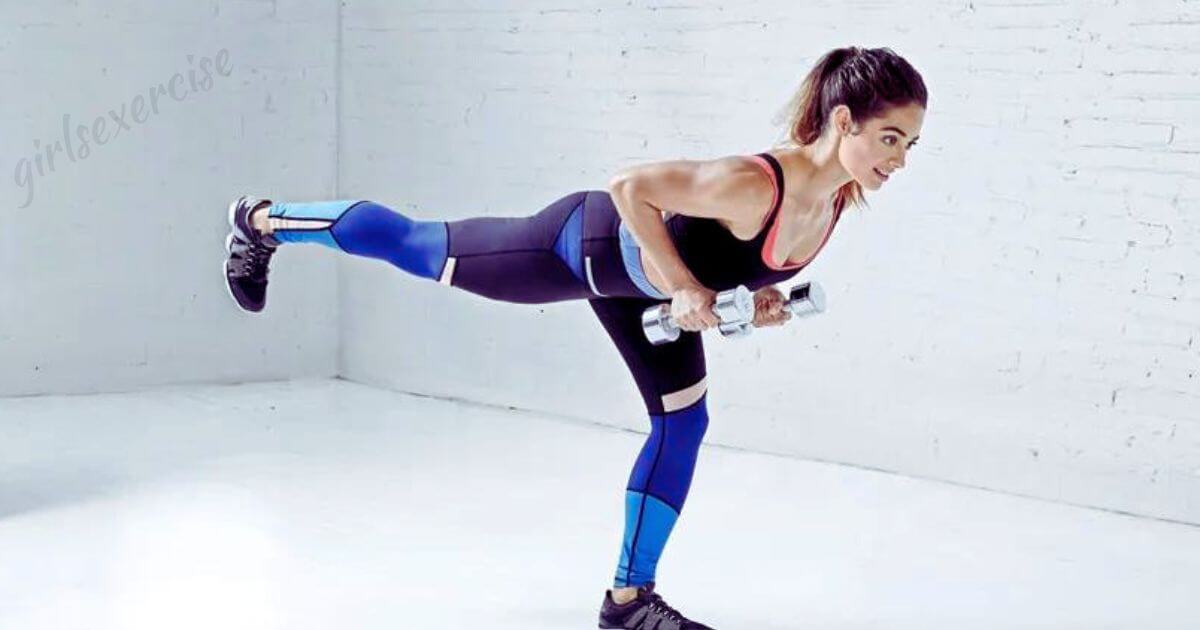Girls’ workout routines embrace tailored approaches to fitness, considering the unique aspects of female physiology. These routines prioritize strength training for lean muscle development, bone density enhancement, and functional strength.
Flexibility and mobility exercises are integral, in preventing injuries and promoting joint health. Cardiovascular training, incorporating HIIT and steady-state cardio, aids in heart health and calorie burning. Nutrition is foundational, supporting energy, muscle recovery, and overall well-being.
Mind-body exercises alleviate stress and boost focus. Finally, community engagement in group workouts fosters motivation, accountability, and a sense of community, making the fitness journey enjoyable and sustainable.
Holistic Warm-Up Rituals For Maximum Impact:

Elaborate Warm-Up Routine: Prior to commencing any exercise regimen, it’s essential to establish a comprehensive warm-up routine. This routine should encompass a variety of elements, such as joint mobilization movements, gentle cardiovascular activities, and dynamic stretches.
This series of preparatory exercises serves a critical purpose, not only in injury prevention but also in optimizing the body’s readiness for peak performance during the workout.
Importance of Joint Mobilization:
A crucial aspect of an effective warm-up is engaging in joint mobilization exercises. These movements aim to enhance the flexibility and mobility of the joints, preparing them for the upcoming physical exertion.
By gently moving the joints through their full range of motion, these exercises help reduce the risk of strains or injuries during the workout.
Significance of Dynamic Stretches and Light Cardio:
Integrating dynamic stretches into the warm-up routine promotes muscle elasticity and range of motion. These stretches involve continuous movements that mimic the actions you’ll perform during the workout.
Incorporating light cardiovascular activities, like brisk walking or jogging in place, elevates the heart rate gradually, warming up the body and increasing blood flow to the muscles.
Prime Your Body for Optimal Performance
Preparation for Peak Performance: Beyond injury prevention, a well-structured warm-up primes the body for optimal performance. It readies the cardiovascular system by gradually increasing heart rate and circulation, preparing muscles and tendons to handle the demands of the workout.
Enhanced Blood Circulation and Oxygen Delivery:
During a thorough warm-up, blood circulation increases, delivering oxygen and vital nutrients to the muscles. This process aids in loosening muscles and improving their responsiveness to subsequent physical activity. As a result, the body becomes more adaptable and better equipped to handle the intensity of the workout.
Improved Neuromuscular Connection:
Engaging in warm-up rituals fosters a better connection between the nervous system and muscles. This connection, known as neuromuscular activation, improves coordination and reaction time, enabling more precise and controlled movements during the workout. It’s an integral aspect of maximizing exercise performance.
Injury Prevention and Long-Term Health Benefits
Safeguarding Against Injuries: A holistic warm-up routine significantly reduces the risk of workout-related injuries. By adequately preparing the body for physical activity, it mitigates the chances of strains, sprains, or muscle pulls.
Consistently incorporating warm-up rituals contributes to long-term musculoskeletal health and overall well-being.
Sustained Musculoskeletal Health:
A consistent warm-up routine not only minimizes immediate injury risks but also contributes to the long-term health of muscles, tendons, and ligaments. It fosters flexibility, maintains joint integrity, and reduces the likelihood of chronic conditions associated with physical inactivity or inadequate warm-up practices.
Psychological Preparation and Focus:
Besides its physical benefits, a holistic warm-up also aids in psychological preparation. It allows individuals to mentally transition into their workout, fostering focus and concentration. This mental readiness enhances the overall exercise experience and contributes to a more rewarding fitness journey
Tailored Strength Training Strategies For Female Physiology:

In-Depth Understanding: Recognizing the distinct nuances of female physiology is crucial when designing an effective workout regimen.
Tailoring strength training exercises specifically for women involves a focus on various facets such as building lean muscle mass, bolstering bone density, and cultivating functional strength. These elements collectively contribute to a holistic approach to fitness.
Emphasis on Lean Muscle Development:
Women often aim for lean muscle development rather than bulk, and a tailored strength training routine aligns with this goal.
Incorporating exercises that engage multiple muscle groups simultaneously, such as compound movements like squats, deadlifts, and lunges, supports the development of lean and toned muscles without excessive bulk.
Bone Density Enhancement and Long-Term Health:
Addressing bone health is paramount in women’s fitness. Strength training exercises that impose controlled stress on bones, like weight-bearing exercises and resistance training, play a pivotal role in enhancing bone density.
This aspect is especially crucial in combating osteoporosis and promoting skeletal strength as women age.
Functional Strength for Everyday Activities:
A key aspect of strength training for females revolves around fostering functional strength. This involves exercises that mimic real-life movements, enabling women to perform daily activities with ease and reduced risk of injury.
Integrating bodyweight exercises alongside free weights enhances overall functional strength and agility.
Utilization of Varied Resistance Training Approaches
Effective Implementation: An optimal strength training regimen for women embraces a diverse range of resistance training methods. Incorporating a mix of free weights, resistance bands, and bodyweight exercises presents an effective and versatile approach to achieving fitness goals.
Free Weights for Progressive Resistance:
Integrating free weight exercises, such as dumbbell or barbell workouts, provides progressive resistance. This variation in resistance levels allows for continuous strength gains and challenges muscles in different ways, fostering well-rounded development.
Benefits of Bodyweight Training:
Bodyweight exercises are fundamental in a female-tailored strength training routine. These exercises leverage one’s body weight as resistance, promoting functional strength, enhancing muscle endurance, and offering the flexibility of performing workouts anywhere without specialized equipment.
Integration of Resistance Bands:
Incorporating resistance bands into the training regimen provides a unique form of resistance that complements free weights. These bands offer varying levels of resistance and can effectively target specific muscle groups, contributing to a more comprehensive and adaptable workout routine.
Cardiovascular Training With A Purpose:

In-Depth Cardiovascular Insight: Recognizing the pivotal role of cardiovascular exercises in promoting heart health and calorie expenditure is essential for crafting an effective workout routine.
Incorporating a well-balanced mix of high-intensity interval training (HIIT) to optimize fat loss and steady-state cardio for endurance development forms the foundation of a comprehensive cardiovascular regimen.
Heart Health Enhancement through Cardio:
Cardiovascular exercises are fundamental in fortifying heart health. Engaging in cardio activities such as running, cycling, or swimming elevates heart rate and enhances cardiovascular endurance.
This sustained effort strengthens the heart muscle, improves blood circulation, and reduces the risk of cardiovascular diseases.
HIIT for Efficient Fat Loss:
High-Intensity Interval Training (HIIT) is a powerful tool for burning calories and promoting fat loss.
Alternating between short bursts of intense exercise and brief recovery periods effectively elevates the metabolism, leading to continued calorie burning even after the workout. HI IT’s efficiency makes it a valuable cardio routine aiming for fat loss.
Endurance Building with Steady-State Cardio:
Incorporating steady-state cardio exercises, like brisk walking or steady cycling, focuses on endurance development. This sustained, moderate-intensity effort helps improve the body’s ability to endure longer periods of physical activity, enhancing overall stamina and aerobic capacity.
Tailoring Cardio for Personal Motivation and Consistency
Customized Cardio Approach: Understanding individual preferences and aligning the cardio component of the workout routine with personal interests plays a vital role in sustaining motivation and consistency.
Finding Enjoyment in Cardio Activities:
Tailoring cardio exercises to personal preferences ensures that individuals engage in activities they enjoy. This might include dance-based workouts, team sports, hiking, or even interactive fitness classes. Enjoyment significantly increases adherence to the routine.
Motivation through Goal Setting:
Setting realistic and achievable goals within the cardiovascular training regimen enhances motivation. Whether aiming to increase running distance, improve sprint timings, or simply aiming for consistency in workouts, these goals provide tangible markers of progress, fostering motivation to continue.
Incorporating Variety for Engagement:
Introducing variety in cardio exercises prevents monotony and keeps workouts engaging. This could involve rotating between different cardio activities throughout the week, trying new workout formats, or incorporating outdoor and indoor activities for diversity.
By understanding the multifaceted benefits of cardiovascular training and customizing it to individual preferences, one can create a sustainable and motivating workout routine that not only supports heart health and calorie burning but also ensures consistency and enjoyment in fitness endeavors.
Flexibility and Mobility Work for Long-Term Health:
In-Depth Insight: While often underestimated, the significance of flexibility and mobility exercises cannot be overstated in a well-rounded fitness regimen. These exercises are instrumental in injury prevention, joint health maintenance, and overall physical functionality.
Integrating practices like yoga, Pilates, or dedicated stretching routines holds the key to fostering enhanced flexibility, expediting recovery, and nurturing a well-balanced and functional range of motion.
Injury Prevention through Enhanced Flexibility:
Flexibility exercises play a pivotal role in reducing the risk of injuries during workouts or daily activities. They elongate muscles and tendons, improving their elasticity and resilience.
This increased flexibility lessens the likelihood of strains, sprains, or tears that often result from restricted mobility.
Joint Health Maintenance and Longevity:
Prioritizing mobility exercises contributes significantly to maintaining healthy joints. Such exercises involve movements that lubricate the joints, enhancing their fluidity and reducing stiffness. This practice is especially beneficial in preventing age-related joint issues, and fostering joint longevity and overall mobility.
Functionality through Improved Range of Motion:
Dedicated flexibility and mobility routines pave the way for a more functional range of motion. This enhanced range enables individuals to perform daily activities with greater ease and efficiency. It also aids athletes in achieving optimal performance by allowing for fluid and unrestricted movements.
Incorporating Various Flexibility-Enhancing Practices
Diverse Approaches to Flexibility Work: Embracing a variety of practices and exercises can significantly augment flexibility and mobility.
Yoga for Mind-Body Connection:
Yoga is a multifaceted practice that not only improves flexibility but also fosters a deep mind-body connection. Its varied poses and stretches focus on increasing flexibility, strength, and balance, while mindfulness techniques promote mental well-being.
Pilates for Core Strength and Flexibility:
Pilates emphasizes core strength and stability while enhancing flexibility. Its controlled movements and emphasis on proper alignment and posture contribute to increased flexibility and improved muscle endurance.
Dedicated Stretching Routines:
Incorporating specific stretching routines, whether static, dynamic, or proprioceptive neuromuscular facilitation (PNF), aids in lengthening muscles and improving flexibility. These routines can target specific muscle groups, catering to individual needs and workout requirements.
By recognizing the profound benefits of flexibility and mobility exercises and integrating diverse practices into a workout routine, individuals can safeguard against injuries, maintain joint health, and achieve a functional range of motion that supports overall physical well-being and performance.
Nutrition As A Cornerstone For Performance:

Comprehensive Understanding: A holistic workout routine encompasses not only physical exertion but also a keen focus on nutrition. Highlighting the pivotal role of a balanced diet in meeting energy requirements, facilitating muscle recovery, and nurturing overall well-being is fundamental.
Emphasizing aspects such as hydration, adequate protein intake, and incorporation of nutrient-dense foods becomes crucial in fostering holistic fitness.
Balanced Diet to Fuel Energy Demands:
A balanced diet serves as the primary source of energy for workouts and daily activities. Incorporating a variety of nutrient-rich foods, including whole grains, lean proteins, healthy fats, and a rainbow of fruits and vegetables, provides the necessary fuel to sustain energy levels during exercise.
Muscle Recovery and Repair through Nutrition:
Post-exercise nutrition plays a critical role in muscle recovery and repair. Consuming a blend of protein and carbohydrates within the post-workout window aids in replenishing glycogen stores and initiating muscle repair processes, facilitating recovery for subsequent workouts.
Hydration for Performance Optimization:
Adequate hydration is often overlooked but is integral to optimal performance. Proper hydration supports nutrient transportation, regulates body temperature, and ensures the efficient functioning of muscles. Encouraging consistent intake of water throughout the day is vital for maintaining hydration levels during workouts.
Focus on Key Nutritional Components
Strategic Nutritional Elements: Highlighting specific nutritional components enriches understanding and aids in crafting an optimal diet for fitness enthusiasts.
Significance of Protein Intake:
Emphasizing the importance of protein in muscle repair and growth is essential. Encouraging sources of lean proteins such as poultry, fish, beans, and dairy support muscle recovery, boost metabolism, and aid in achieving fitness goals.
Importance of Nutrient-Dense Foods:
Promoting the consumption of nutrient-dense foods ensures a supply of essential vitamins, minerals, and antioxidants necessary for overall health. Encouraging colorful fruits, leafy greens, nuts, and seeds offers a spectrum of nutrients vital for optimal bodily functions.
Role of Proper Hydration:
Educating on the significance of hydration fosters awareness of its impact on performance. Suggesting water intake guidelines based on individual needs, while also considering electrolyte balance during intense workouts, ensures sustained hydration levels.
By underscoring the critical role of nutrition in supporting energy levels, facilitating muscle recovery, and promoting overall well-being, individuals can optimize their workout routines.
Focusing on a balanced diet, adequate hydration, and key nutritional components establishes a solid foundation for holistic fitness and performance enhancement.
Mind-Body Connection For Stress Relief And Focus:
Insightful Practice: Integrating mind-body exercises, such as meditation or mindful breathing, into a workout routine offers significant benefits in stress relief and concentration enhancement.
Recognizing the mental aspect of exercise not only aids in physical well-being but also fosters emotional and mental balance, nurturing a holistic approach to overall health and fitness.
Stress Relief through Mind-Body Practices:
Mind-body exercises act as powerful tools in alleviating stress. Techniques like meditation or deep breathing activate the body’s relaxation response, reducing stress hormones and promoting a sense of calmness and tranquillity. Regular practice enhances resilience to stressors encountered in daily life.
Improved Focus and Concentration:
Engaging in mind-body exercises bolsters focus and concentration levels. These practices cultivate mindfulness, which heightens awareness of the present moment. This heightened awareness translates into improved focus, enabling individuals to concentrate better on tasks and workouts, enhancing overall performance.
Emotional and Mental Well-being:
The mental aspect of a workout routine significantly impacts emotional and mental health. Mind-body exercises contribute to emotional regulation, fostering a sense of emotional balance and stability. They also provide a space for self-reflection, aiding in managing anxiety and promoting mental clarity.
Holistic Approach to Health and Fitness
Comprehensive Well-being: Recognizing the integration of mental and physical aspects in fitness cultivates a holistic approach to health.
Emotional Resilience and Coping Mechanisms:
Mind-body exercises equip individuals with tools to build emotional resilience. These practices serve as coping mechanisms, enabling individuals to navigate stressors more effectively and maintain emotional equilibrium.
Mental Clarity for Optimal Performance:
A clear and focused mind enhances overall performance. Mind-body exercises contribute to mental clarity, reducing distractions and enabling individuals to engage more deeply in workouts, thereby optimizing the benefits derived from physical exertion.
Long-Term Psychological Benefits:
Consistent engagement in mind-body exercises yields long-term psychological benefits. It fosters a positive mindset, reduces the impact of negative thoughts, and supports mental well-being, establishing a foundation for sustained health and fitness.
By acknowledging the impact of mind-body exercises on stress relief, focus enhancement, and overall emotional and mental well-being, individuals can cultivate a balanced approach to health and fitness, fostering resilience, focus, and long-term psychological benefits.
Periodization For Progressive Results:

Strategic Training Method: Employing a periodized approach in training is pivotal for achieving continuous progress. This method entails organizing the workout routine by manipulating intensity and volume across defined time frames.
Its purpose is to thwart plateaus, minimize burnout risks, and maintain a consistently challenging and rewarding workout regimen.
Preventing Plateaus through Varied Intensity:
Periodization disrupts performance plateaus by alternating training intensities. It involves cycles of high-, moderate, and low-intensity workouts strategically designed to challenge the body, promote adaptations, and prevent stagnation in progress.
Mitigating Burnout Risks:
The structured nature of periodization reduces the likelihood of burnout by incorporating periods of lower intensity or active recovery. These phases allow the body to recuperate, preventing overtraining and mental exhaustion, and ensuring sustained motivation.
Sustaining Challenge and Reward:
By varying intensity and volume, periodization ensures that workouts remain stimulating and engaging. This constant variation challenges the body in different ways, keeping workouts interesting and maintaining motivation through achievable milestones.
Implementing periodization within a workout routine acts as a strategic roadmap, preventing stagnation, minimizing burnout, and sustaining a consistently challenging and rewarding exercise regimen.
Community Engagement And Supportive Networks:

Community-Centric Emphasis: Encouraging girls to participate in group workouts, fitness classes, or sports teams fosters a sense of belonging and support.
Creating and nurturing a supportive network offers motivation, accountability, and a strong sense of community. This social aspect enhances the enjoyment and sustainability of workout routines over the long term.
Motivation through Collective Efforts:
Engaging in group workouts or team sports fosters motivation. Being part of a community that shares similar fitness goals encourages individuals to push their limits, stay committed, and derive inspiration from the collective progress.
Accountability and Commitment:
A supportive network provides a layer of accountability. When girls are part of a community, they feel a responsibility towards their fitness commitment, driving them to show up consistently and stay dedicated to their workouts.
Sense of Belonging and Camaraderie:
Building a community creates a sense of belonging and camaraderie. It creates an environment where individuals feel understood, supported, and valued, fostering a positive outlook on their fitness journey.
Encouraging girls to engage in group fitness activities or team sports cultivates a supportive network that not only motivates and holds them accountable but also creates a sense of belonging, making their workout routines more enjoyable and sustainable in the long run.
Conclusion:
Encouraging girls to engage in group workouts, fitness classes, or sports teams fosters a sense of belonging and support.
Building a supportive network around girls’ workout routines not only provides motivation and accountability but also creates a positive community environment, enhancing the overall enjoyment and sustainability of their fitness journey.
Fostering a community-centric approach within girls’ workout routines by promoting group activities and supportive networks proves instrumental in enhancing motivation, accountability, and the overall long-term success of their fitness endeavors.
This social engagement adds a valuable dimension to individual workouts, contributing to a more enjoyable and sustainable approach to health and well-being.
Faqs About Girls’ Workout Routine
What makes a girls’ workout routine different from a general workout routine?
Girls’ workout routines are tailored to address the unique aspects of female physiology, emphasizing strength training for lean muscle development, bone density enhancement, and functional strength.
Can girls engage in heavy lifting as part of their workout routine?
Absolutely. Incorporating heavy lifting in girls’ workout routines is beneficial for building strength and lean muscle mass. It dispels the misconception that heavy lifting leads to excessive bulk, focusing instead on sculpting a toned and resilient physique.
How do flexibility and mobility contribute to a girl’s workout routine?
Flexibility and mobility exercises are integral for injury prevention and joint health. Incorporating practices like yoga and stretching routines enhances flexibility, aids in recovery, and promotes a balanced range of motion, crucial for overall well-being in a girls’ workout routine.
Is cardiovascular training essential for girls’ fitness routines?
Absolutely. Cardiovascular training plays a vital role in improving heart health and burning calories. Girls’ workout routines benefit from a mix of high-intensity interval training (HIIT) for fat loss and steady-state cardio for endurance development, tailored to individual preferences.
How does nutrition play a role in girls’ workout routines?
Nutrition is a cornerstone for girls’ workout routines, supporting energy requirements, muscle recovery, and overall well-being. Emphasizing a balanced diet, adequate protein intake, and staying hydrated are vital components of holistic fitness.
Why is the mind-body connection emphasized in girls’ workout routines?
Mind-body exercises like meditation or mindful breathing contribute significantly to stress relief and improved focus. Recognizing the mental aspect of the workout routine is essential, nurturing emotional and mental well-being alongside physical health.
What is the importance of community engagement in girls’ workout routines?
Community engagement is crucial as it provides motivation, accountability, and a sense of belonging. Encouraging girls to participate in group workouts or fitness classes fosters a positive and supportive network, making their workout routines more enjoyable and sustainable over the long term.



